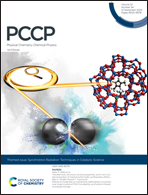One-electron redox kinetics of aqueous transition metal couples Zn2+/+, Co2+/+, and Ni2+/+ using pulse radiolysis†
Abstract
The one-electron redox potentials for aqueous metal couples Co2+/+ and Ni2+/+ have been investigated by using pulse radiolysis using their reactions with a series of reference compounds to establish the most positive upper limits of E0. Experiments with Zn+ were also carried out to confirm the characteristic shape of the expected reduction kinetics. Both formate ions and t-BuOH were employed to scavenge ˙OH radicals and ˙H atoms. Kinetics and fitted first and second order reaction rates have been reported for reactions with methyl viologen, fluorescein, Ru(NH3)63+, Co(en)32+, Co(sepulcrate)3+, Ru(bpy)32+, Cr(bpy)33+, and Ni(Me6[14]4,11-dieneN4)2+. Previous work demonstrated that both Co2+ and Ni2+ can be reduced by CO2˙− radicals, giving a negative E0 limit of −1.9 V vs. SHE. A definite reaction of Ni+ with fluorescein di-anions provides a new upper limit of the Ni2+/+ couple as −0.906 V vs. SHE. The reaction of Co+ with Ru(bpy)32+ has been confirmed, giving E0 = −1.3 V vs. SHE as a rigorous upper limit of the Co2+/+ couple. In the case of Co2+/+, kinetics were complicated by a self-catalyzed metal clustering phenomenon. Initiation rate constants of this process have also been reported.

- This article is part of the themed collection: 2020 PCCP HOT Articles


 Please wait while we load your content...
Please wait while we load your content...